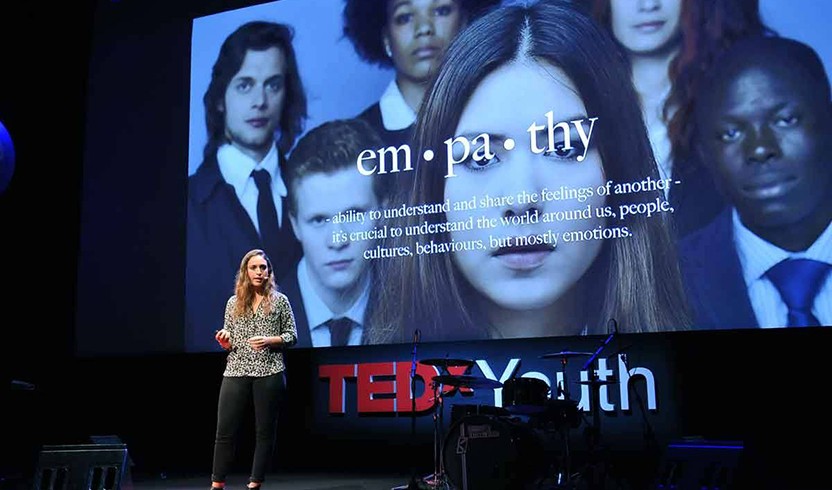Designing for Empathy
We are facing a crisis of empathy. In the past 20 years we’ve seen a 40% decline in the markers for empathy among college student in the United States. Research shows that even a silent phone on a lunch table between two people causes them to share less with each other, let them feel less connected, less interested and less empathic towards each other.” says MIT Professor Sherry Turkle. Our concentration is constantly broken, at least I admit, mine is. We are getting more and more distracted, always being here but everywhere else, always connected and available but never really present in the moment. We are having so hard times focussing on just one thing, finishing a book, reading an article (i.e. also this one), finishing a simple task without checking our mails, not even anymore able to finish a conversation without checking our phones or our smart watch notifications. We spend hours together, without making eye contact. Technology is not just changing how we do things but also who we are. As a Designer I feel the urgency to face this crisis of empathy, to really design solutions to connect people at a more emotional level. Design has matured from a largely stylistic endeavor to a field tasked with solving thorny technological and social problems, an evolution that will accelerate as companies enlist designers for increasingly complex opportunities, from self-driving cars to human biology. My theory is that we are shifting from a Human Centred Design to an Emotion Centred Design approach. Designing for Empathy is a method based on 3 steps: Learn, Feel, Spread
Step #1 Learn.
Design training needs to evolve, we need to focus more on studying emotions. As designers we are trained to research and study people needs, make quantitative and qualitative research, understand the market, study technologies, materials, colors, shapes and softwares but we should focus more on “emotion studies”, studying the basic of emotions, learning compassion, fear, anger, how to manage stress, empowering our emotional intelligence.
Step #2 Feel.
To be good Designers our mission is to have a fulfilling life, full of emotions, curiosity and wonder. We need to be the first to test, feel, jump, watch in others eyes, sit in silence for a day, live a day as a tibetan monk, live a day as a blind person, live as an homeless… We need to take brave decisions, to take risks and to don’t have the fear of asking.
Step #3 Spread.
Success matrix for products, digital experiences and services needs to shift from a time based matrix to an emotion and happiness based one. A successful product should be defined not on the clicks, or time you spend using it, but on the real deep connections you trigger, on the generated conversations, shared moments with strangers and the time spent doing positive things for other people. It’s really up to us to escape from being locked into our screens, to appreciate simplicity, to breath, to feel, to focus, to get bored, to talk and to empathise with each other.
I’m not against technology or smartphones, I’m actually an enthusiast of Singularity and technology exponential growth, but I believe that the future of internet is out of our screens, spread into the real world around us in smart and embedded in magic enchanted objects and infrastructures. As reality is richer than screens, we need to dream, build and design a world without being stuck in designing just the UI (User Interface) and UX (User Experience) screen interactions. Yesterday’s industrial and graphic designers are today’s UX designers. Will tomorrow’s UX designers will be machine learning designer, avatar programmers, fusionists, and empathy and emotions designers? I was born as industrial designer, then worked between product and communication design, then shifted to service and UX designer but my main focus has always has been and always will be enhancing people’s interactions and experiences with the world around them and between themselves.
I believe our challenge as designers is to work at the intersection of AI, Machine learning and psychology and anthropology. We need to work side by side with deep learning engineers, physiologists and neuroscientists to design a future which is not driven by technology, but is driven by compassion and joy. The complexity of the world we live is constantly growing. Overpopulation, worldwide conflicts, gender discrimination, environmental pollution, lack of resource, global ethics… The only way I see to manage all these wicked problems and growing complexity is through designing for empathy and using technology as a medium, while focussing on emotions. At Awake, one of our main focus is to revert this trend. In our project we try to leverage digital tools and social dynamics with the main goal of establishing in person human relationships because we strongly believe that we have more valuable things in life than spending time looking at a screen. Our mission as designers is to train people empathy muscles, to
Source: Designing for Empathy – Loves by Domus
by Caterina Falleni


